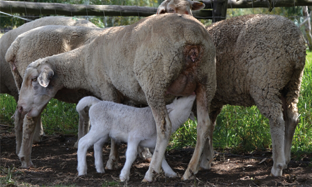
Johne’s Disease (Paratuberculosis) in Sheep
Johne’s Disease, or Paratuberculosis, is a chronic, contagious disease of ruminants and certain types of game which is caused by the bacterium Mycobacterium avium subspecies paratuberculosis. This bacterium is closely related to the organism that causes Tuberculosis or TB. The disease occurs worldwide and is regarded as one of the biggest threats to the livestock industry in countries such as the UK, Australia, New Zealand, and Spain.
In South Africa, sporadic cases of paratuberculosis in cattle were reported since the first case was confirmed in 1923. In sheep, the disease was limited to two flocks in the previous Transvaal. In 1993, the first case in sheep was however confirmed in the Western Cape.
Affected or carrier animals can excrete large quantities of the bacterium in their dung. The paratuberculosis bacterium is very resistant and can survive under favourable conditions (a moist, cool environment), for more than a year in dung or water. Susceptible animals ingest the bacterium orally through contaminated grazing or, in younger animals that are more susceptible than older animals, by suckling on contaminated teats. The bacteria enters the intestinal tract where it multiplies. Some infected animals become carriers and can excrete the bacterium through their dung for their entire lives. Most infected animals remain subclinical carriers; in other words, they remain apparently healthy and show no symptoms of the disease. Others may, however, after an incubation period that can vary from six months to as long as several years, develop clinical symptoms. The percentage of a herd that develops clinical symptoms is usually 1-2% per year but can be as high as 10% per year. Factors such as malnutrition, trace elements deficiency and internal parasites may increase the number of clinical cases.
In sheep that show clinical signs, chronic emaciation is observed, but the droppings are usually normal. Diarrhoea is typically not one of the disease’s symptoms in sheep. Due to the disease’s long incubation period, clinical cases are usually only observed in sheep from 2-tooth and older sheep.
Affected animals die after a few weeks or months due to starvation because the bacterium causes the intestinal wall to thicken, with the result that nutrients cannot be absorbed. There is no treatment for the disease, but a vaccine is available on prescription from a State Veterinarian.
There are many other causes for emaciation in sheep, such as malnutrition, a deficiency in trace elements, internal parasites, abscesses, etc. and it is very important that Johne’s Disease is confirmed if it is at all suspected. It is a Controlled Disease and any suspicious or confirmed cases must be reported to the closest State Veterinarian.
In Conclusion
- Sheep are infected when they are very young lambs by this organism (that also contaminates the entire environment) by ingesting it orally.
- Although Johne’s disease is rare in goats, they are still susceptible.
- The period from contamination until the first clinical signs present can vary and is very long. Clinical signs of emaciation and poor production are generally observed from the 2-tooth age and older.
- The disease cannot be reliably diagnosed in its early stage.
- The available tests are generally not sensitive enough and no affordable, reliable test to determine individual animals’ status is available.
- The vaccines that are available in other countries have varying results and cause large swelling in some small lambs after administration. A vaccine (Gudair) is now available in South Africa but only on prescription from a State Veterinarian.
- The organism is excreted in large quantities in infected animals’ dung and can survive for many months, especially in cool and damp conditions.
In view of the above, the only advice for a producer with an infected flock is the following:
- Keep the average age of the herd as young as possible.
- Remove and slaughter, any clinically affected animal(s) (emaciated sheep) as soon as possible. They excrete large quantities of the organism through their droppings and this infects the other sheep.
- Lambing in winter (when it is cold and wet; see above) increases the likelihood of lambs becoming infected. Let the sheep rather lamb in spring.
- Ewes must lamb on clean lands, such as stubble land or medics that is re-established every year. Do not let ewes lamb in small camps.
- Separate older and younger ewes if practically possible.
- Maintain strict hygienic conditions. Water and feed troughs must be kept clean and be designed in such a way that contamination by dung cannot take place. Feeding troughs must be elevated from the ground to prevent contamination from droppings. Don’t feed sheep using tyres that lie on the ground.
- Try to keep the nutritional status (especially in terms of trace elements and vitamins) and health status (parasites and diseases) of the herd as high as possible so that animals have a stronger resistance against the disease.
- Try to keep a closed flock and do not purchase or bring in sheep from a contaminated farm.
- Guard against contamination at auctions (where unsold animals can become infected and are then returned back to the farm), shows, and the mustering of animals from different origins, like at core flocks, production / study groups, etc.
- Ewe lambs can be vaccinated against the disease at tail docking, . Due to the swelling at the site caused by the vaccine , this should preferably be done in winter when the risk of blowfly attack is low.
- Spread lime on the ground to increase its pH and in so doing control the survival of the organism.
Acknowledgement to Dr S Davey , State Veterinarian Malmesbury for this article.

